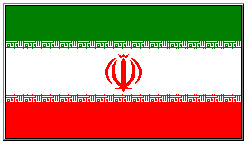|
 
Iran
(official Islamic Republic of Iran), state in Asia, borders in the N on Armenia, Azerbaijan and Turkmenistan, in the
E on Afghanistan and Pakistan, in S on the Persian Gulf and the Gulf of Oman, in the W at Iraq, in NW to Turkey.
Surface
1,648,000 km2
Inhabitants
approx. 65 million
Capital
Tehran
Administrative arrangement
24 provinces
Office language
Persian
Public holidays in 2000
01.02., 19.-23.03., 25.03., 01.04., 15.04., 25.05., 03.-04.06., 20.06., 02.09., 11.10., 25.10., 12.11., 18.12. + 27.12.2000
Currency
1 Rial (Rl) = 100 of dinar (D.)
Time belt
CET +2 1/2 hrs.
National nature
I. is in nature a highland between Casp. Sea and the Pers. Gulf. In the N it is limited by the Koppe Dagh and the Elbursmountains (Demawend 5,671 m), in the W and SW by the Sagros and Kuhrudmountains. In the NW is situated the Urmialake, the largest lake of the country. Only south of the Casp. Sea and at the internal end of the Pers. Gulf occur coastal low countries. The highland is large in the center and in the E desert (Dascht e Kawir, Lut). I. has continental climate and is situated in the transient area of the drying belt of the trade-wind zone to the central Asian Desert belt. Deserts and half deserts dominate. In the W and NW drying forest occurs.
Population
Beside the Persians there are about 12 millions Azerbaijanis, Kurds, Arabs and Armenians, additionally Masandaranis, Lurs and Beluts. The number of the Nomads became 1965 on 3 millions estimated. 98% of the inhabitant are Muslims (almost throughout Shiites). I. has 17 universities.
Economics, traffic
The agriculture, on which about 70% of the population live, furnishes 20% of the gross domestic product. Are cultivated to wheat, barley, rice (in southcasp. Coastal low country), tobacco, lemonfruits, cotton and tea. Important fishing of sturgeon (caviar production) in the Casp. Sea. The backbone of Iran. Economics are oil and natural gas. Further considerable mineral resources are iron and copper as well as hard coal. Centers of the iron
and steel Ind. are Ahwaz and Isfahan. An important economic factor is the textile industry. The net of railways is 4
,567 km, asphalt road system 138,592 km long. The most important ports are Khorramschahr, Bandar Imam Khomeini and Bandar Abbas. International airport: Mehrabad Airport, Tehran.
History
Modernization of state and society: Beginning of the modern development of Persia (Persian history), since 1934 I.
towards, under Shah Reza Pahlawi ("1925-41); process of the expropriation of the small farmers accelerated at
the same time. After the attempt of an approximation to national-socialist Germany 1941 banishing the Shahs by
the allied ones in favour of its son Shah Mohammad Reza Pahlawi. Increasing influence of the USA. The attempt of
Minister President Mossadegh to solve the country from the economic Supremacy of Great Britain, undertaken
because of the oil question 1950, failed 1953. Oil agreement of 1954: theoret. Nationalization of the oil Ind., but
control function of societies of the USA, France and the Netherlands. Economical and social reforms (›White
Revolution‹) due to continuous strikes in the oil Ind. (1956-61). 1955 entry to the Baghdad pact. Intensification
polit. and econom. relations with the FR Germany (1974 and 1976 agreement for participation in the Krupp
company), to Greatbrit. and the USA (1959 defense agreement). Besides effort around a good relation to the USSR
and other communist. States. Omissions at the time of the execution of the ›White Revolution‹, the social consequences of rushed into industrialization, fear forwards western foreign infiltration of the country,
resistance of the shiit. Religiousness against the modernization, the brutal methods of the secret police SAVAK led
to the failure of the Shahregime. After a general strike and the revolutionary, led by Ayatollah R. Khomeini from
exile in Paris, between August 1978 and January 1979 Shah Reza Pahlawi was forced to leaving the country (16th Jan. 1979).
The Islam. Republic under Ayatollah Khomeini: In the Feb. 1979 Khomeini returned from Paris exiles. On 30. 3. 1979
acceptance of Khomeini announced ›Islam. Republic‹ by popular vote. At the 2./3. 12. 1979 decision of a popular
vote for the new condition. Fact. Nationalization of the oil industry. As consequence of the strained economic
situation, among other things intensified by the war with Iraq (the Gulf War), in January 1983 governmental foreign trade monopoly has been given up.
After the long lasting Gulf War Ayatollah Khomeini appointed the president of parliament Rafsandjani to the new
commander in chief of the armed forces. At the end of July 1988 could I. under mediation of the UN Secretary
-General J. Pérez de Cuéllar a cessation of hostilities with Iraq agree upon. The two war opponents agreed also the
stationing of a UN peacekeeping force at the gulf. The discussions running starting from at the end of August 1988
remained until 1990 without result, since none of the two states of its maximum demand in the border question at
the Shatt al Arab wanted to go off. Only as consequence of the occupation of Kuwait by Iraq it came in the Sept.
1990 for a prisoner change and the Iraq. Acknowledgment of the boundary to I. in the center of the Shatt al Arab.
Political system
Islam. Republic; Condition from 1979 (modified 1989) be based on the ethics of the Islam schiit. Direction. Head of state is of the people on 4 years of selected President with executives authority; he appoints the Ministers; its
powers are reduced by a religious highest instance, the ›Leader of the Nation‹ (since 1989 Hadjatoleslam A. Khamenei). Legislation is the a 1-chamber parliament (national assembly; 270 members of parliament, selected by
the people on 4 years). Laws and regulations require the agreement of the ›Rates guard of the Islam‹ (6 Islamic
lawyers appointed by the ›Leader of the Nation‹ and 6 lawyers selected by the parliament), a 1989 created control organ for the examination of the compatibility of the laws with the Islamic Justice.
Armed forces: about 600000 men.

|